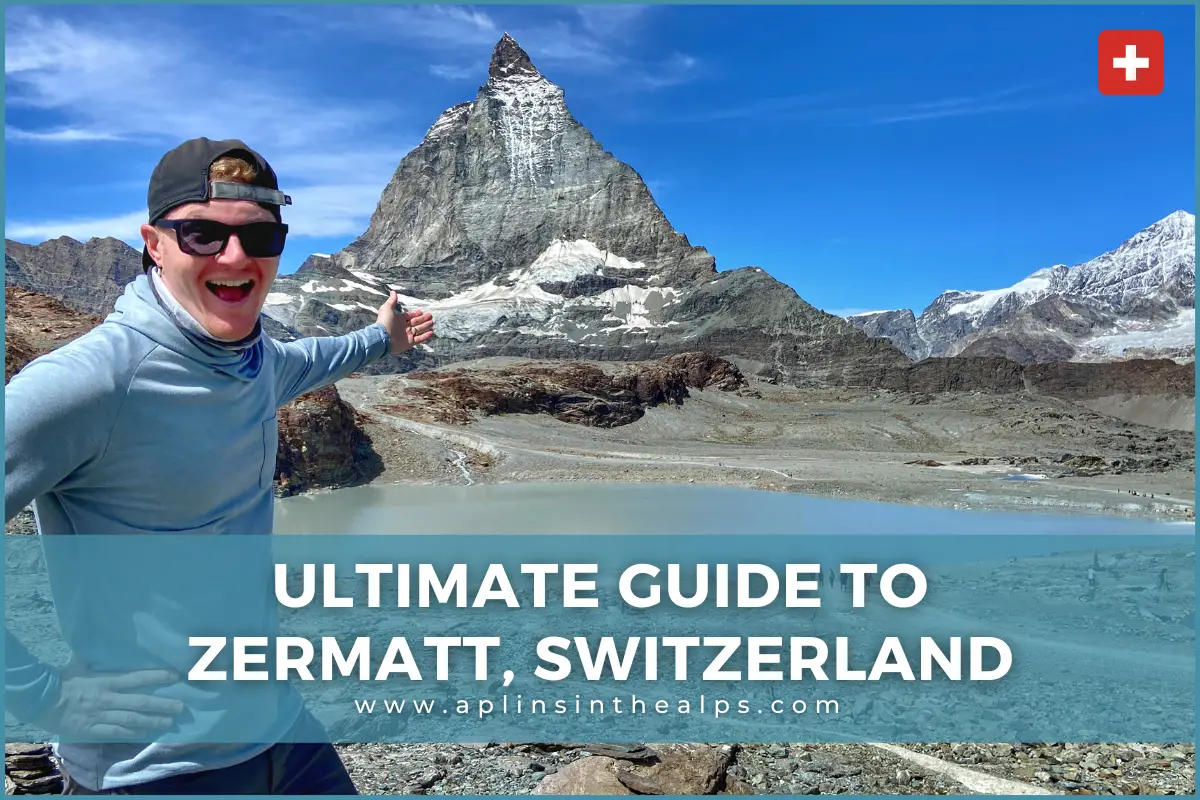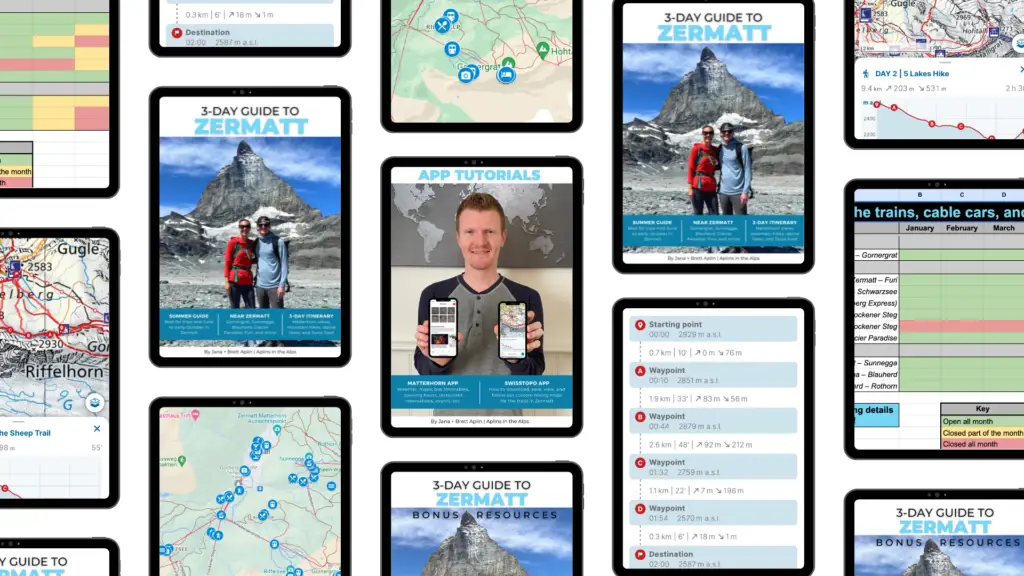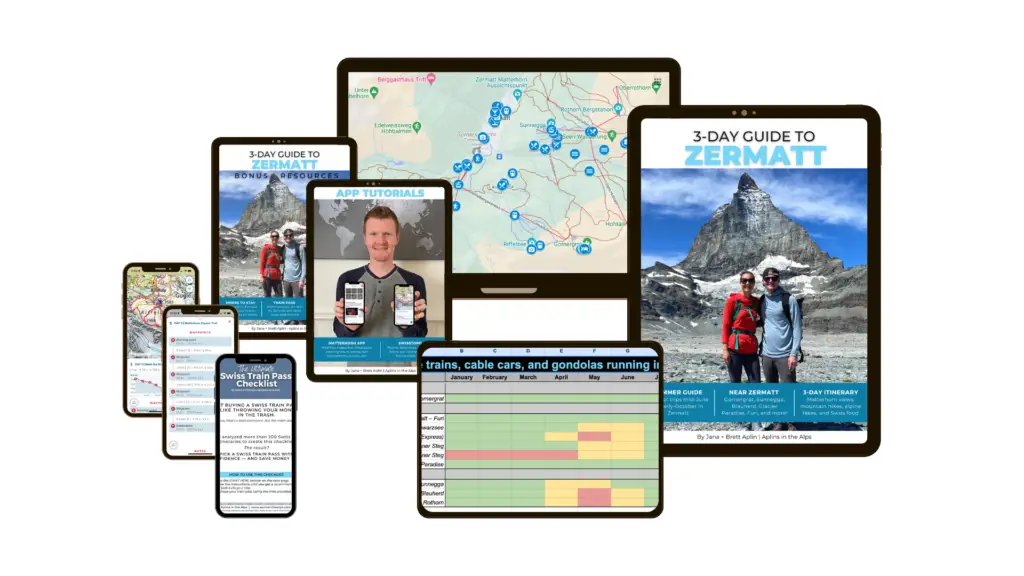If hiking with Matterhorn views, scenic train journeys, epic cable car rides, and some of the best food in Switzerland sounds like fun to you, then you will not want to skip Zermatt on your next trip to Switzerland!
But Zermatt can be tricky to travel if you’re not prepared.
- How do I get to Zermatt?
- Where can I see the Matterhorn?
- How long should I stay?
- What else should I do besides Glacier Paradise?
- What’s the best time of year to visit Zermatt?
- Is there a train pass for Zermatt?
Today we’re going to answer your biggest questions and make you Zermatt-ready!
Want to Watch instead of Read?
What makes Zermatt, Switzerland so special?
The number one reason people visit Zermatt is to see the Matterhorn, of course!

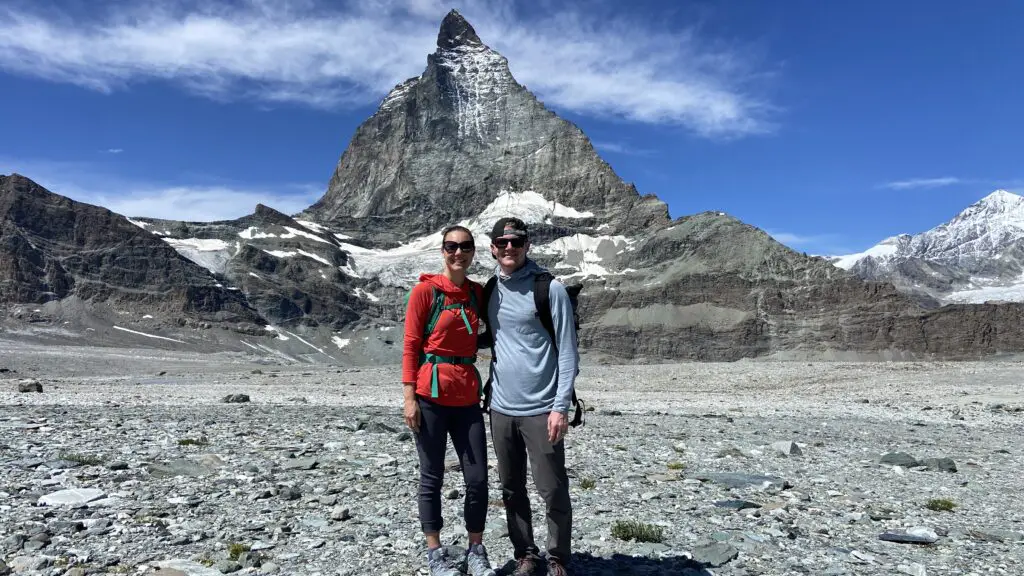
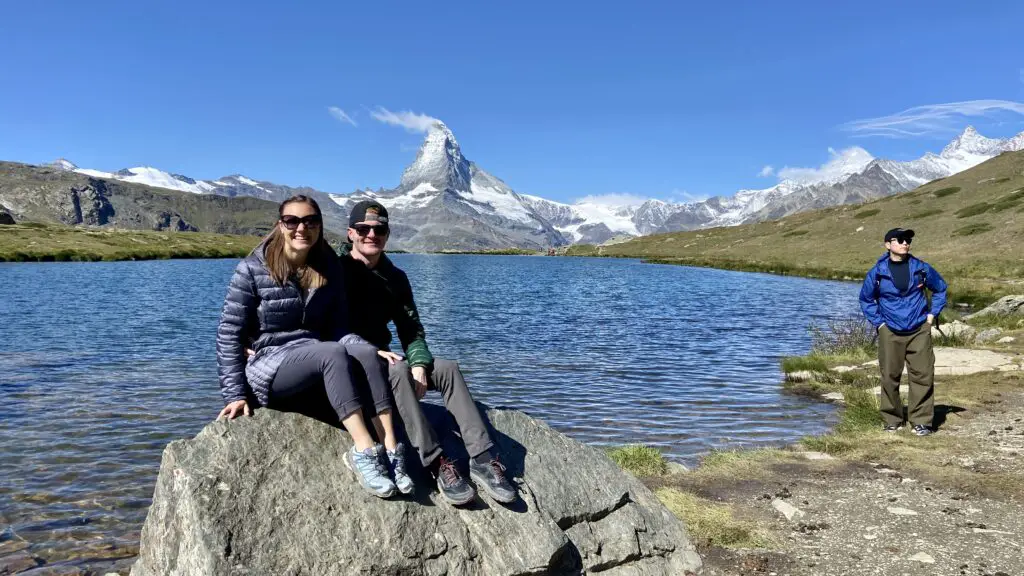
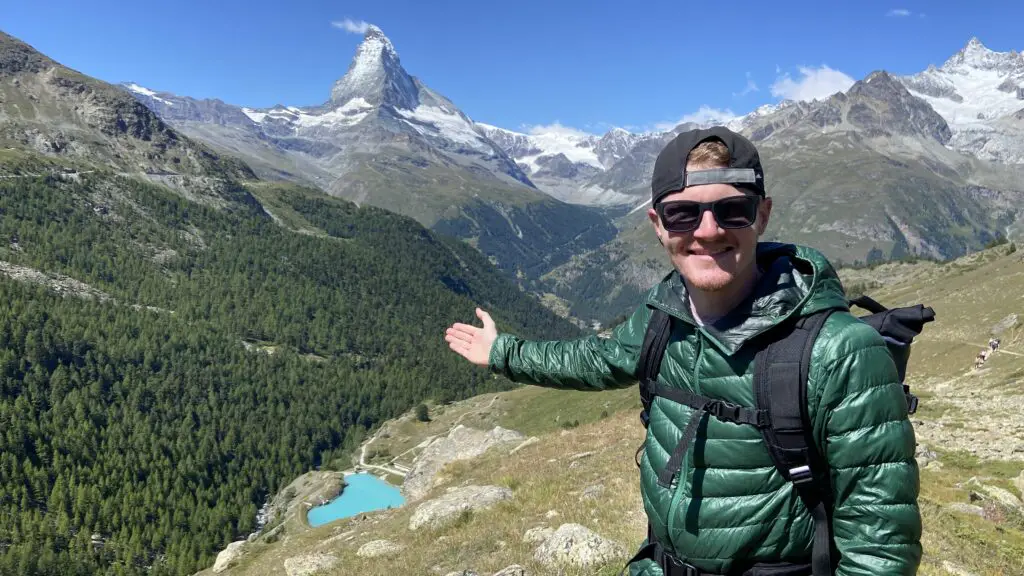
The Matterhorn is the most-photographed mountain in the world. Its fame dates back to 1865 when there was a race to see who could summit this mighty peak first.
Spoiler alert: That story has a tragic ending, and you can learn more about it in the Matterhorn Museum.
But ever since then, it’s been the center of attention for mountaineers and tourists alike.
In fact, more than 50% of Zermatt’s economy is fueled by the tourism industry. And that’s because people just can’t get enough of this imposing pyramid.
ZERMATT INSIDER TIP #1
So here’s our first insider tip: You don’t have to go way up into the mountains to see the Matterhorn. You can get great views from all-over-the-village! Especially if you walk to the far end of town or along the river.
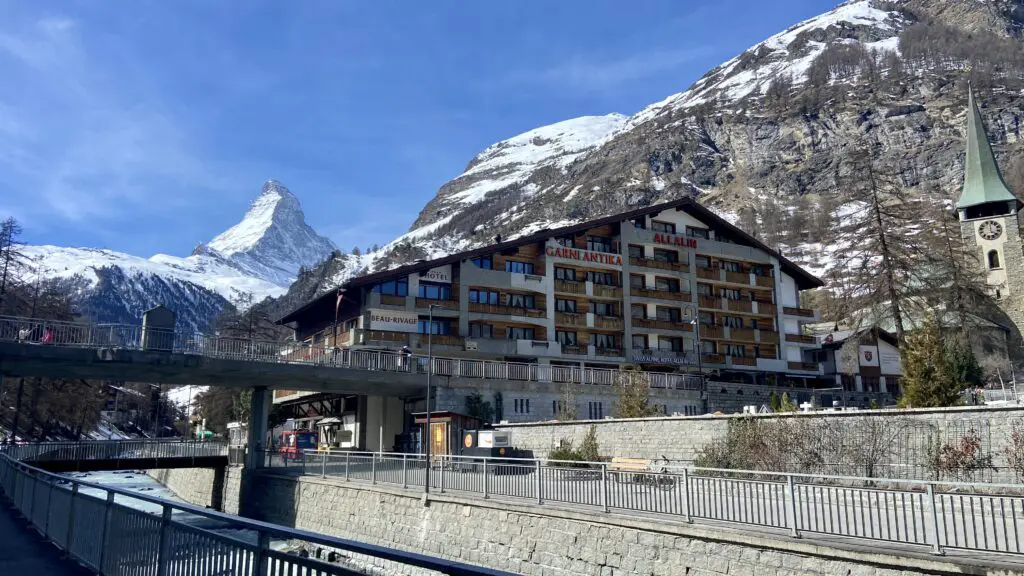
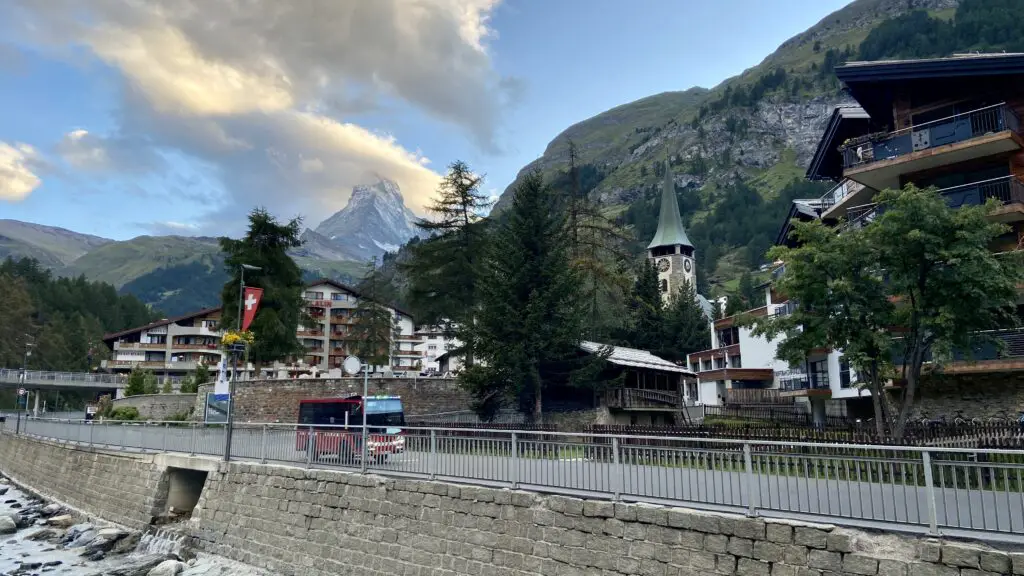
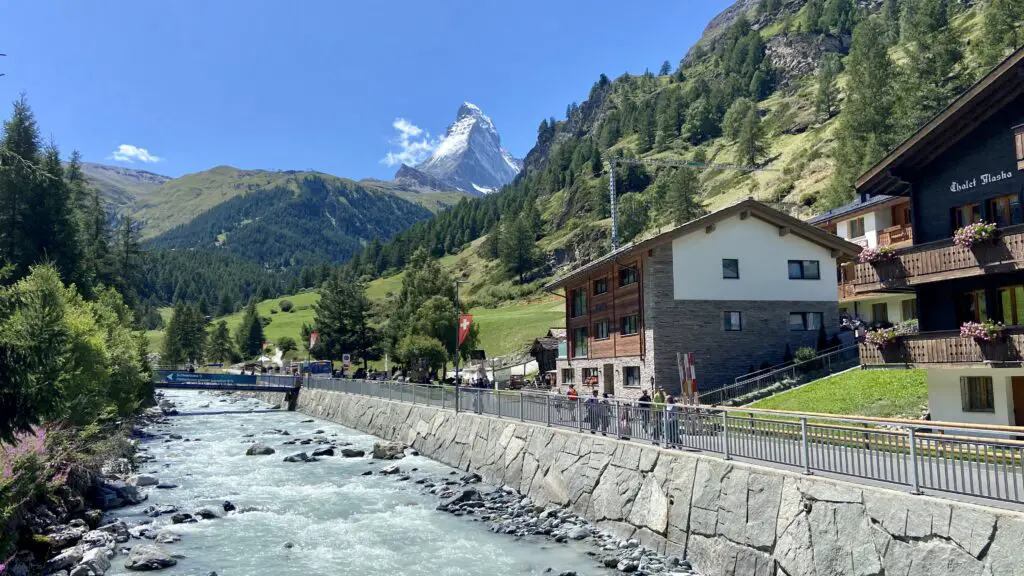
You might be visiting just to see the most-recognized mountain in the world, but there’s a whole lot more to Zermatt!
Tourists also come to see the adorable and friendly blacknose sheep. And if you follow the Meet The Sheep Trail, you can even pet them and meet their shepherdess (which is one of my personal highlights from Zermatt).

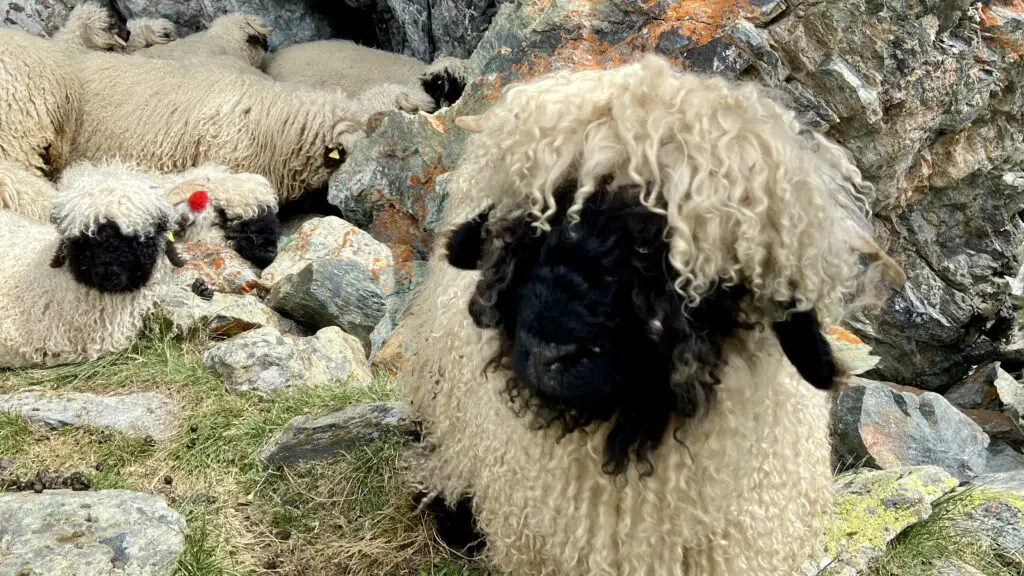
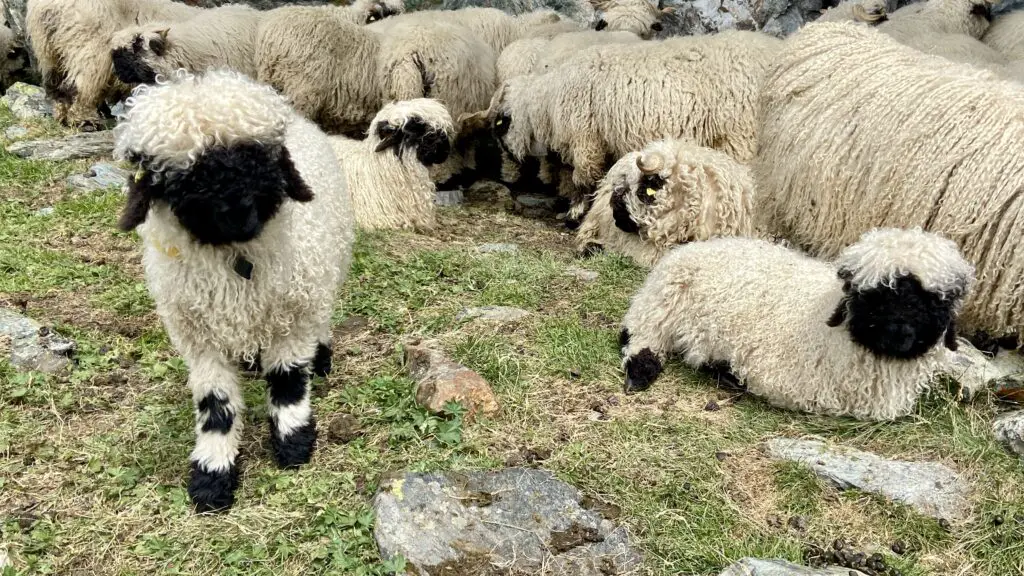

You can also watch black-necked goats parade through the village twice a day.
Not to mention that edelweiss naturally grows all over the place here. (I also bought some edelweiss to take home with me, which died in the heat of summer, but it was fun while it lasted!)

And of course this is a paradise for mountain adventures, which we’ll talk more about later. And we unpack those even deeper in our 3-Day Guide to Zermatt.
How to reach Zermatt
But first things first: How do you get to Zermatt? By train, it’s 3.5 hours from the Zurich Airport, about 4 hours from the Geneva Airport, almost 4 hours from the Basel Airport, and 3.5 hours from the Central train station in Milan, Italy. We live near Interlaken, which is about 2 hours and 15 minutes away by train as well.
ZERMATT INSIDER TIP #2
But insider tip #2 is that you cannot drive to Zermatt!
You can drive your car as far as Täsch, which is a village just 5 kilometers from Zermatt. You can park your car there in the giant parking garage for around 16 CHF per day. And then you ride the train the rest of the way to Zermatt. The train runs every 20 minutes and the ride is only about 15 minutes long.
Arriving in Zermatt
This means that your very first steps in Zermatt will be at the Zermatt train station. And this is a pretty good starting point to understand where things are located in Zermatt, so why don’t we show you around the village?

Just outside of the train station is the main square where you’ll find the Tourism Office and a few convenient shops, like a pharmacy and mini market.
Oh, this is where you’ll probably see a bunch of e-taxis and horse drawn carriages too. Zermatt has been a car-free village for nearly its entire history. The first electric vehicle came here in the 1940s and they continue to use electric vehicles to protect the valley from pollution.
So even though Zermatt is a car-free village, there are still lots of vehicles here threatening to run you over!
Zermatt is very walkable. But depending on where your hotel or Airbnb is, you might not wanna drag your luggage through the streets. So you have 3 options: free e-buses, paid e-taxis, or our third insider tip…
ZERMATT INSIDER TIP #3
See if your hotel has a shuttle. Many of them offer this service to their guests or you can reserve it in advance. You just call them from the train station to pick you up! In fact, one of the hotels we stayed at picked us up in a horse drawn carriage! It felt very luxurious…but also a bit awkward to ride through a busy pedestrian street in a carriage.
Orientation to Zermatt Village
Before we start walking down the main pedestrian street, we wanted to point out the Gornergrat Railway Station which is literally just across the street. A 30-minute scenic train takes you up to Gornergrat where you have a stunning view of 29 mountain peaks over 4000 meters, endless sparkling glaciers, and of course the Matterhorn!
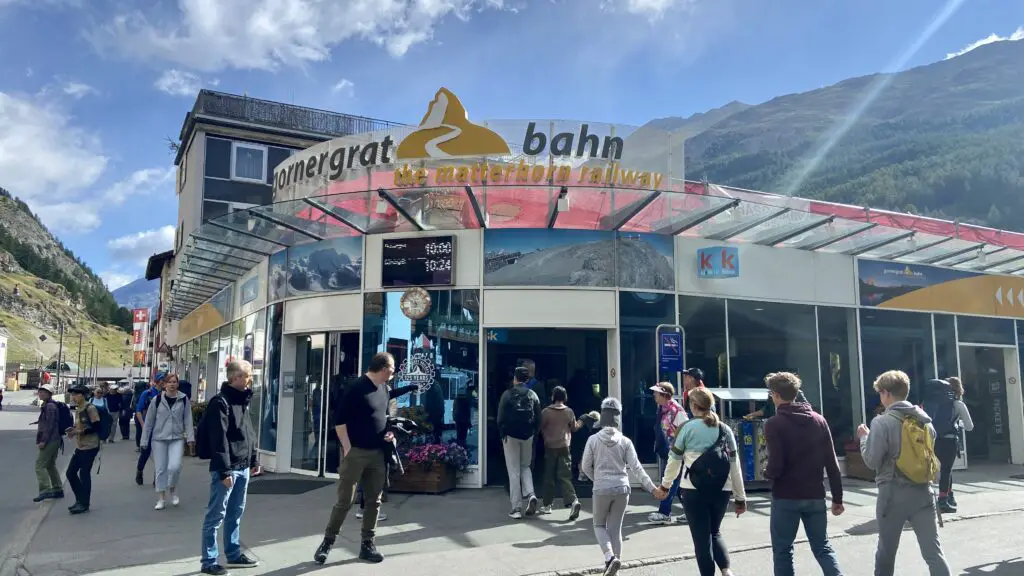
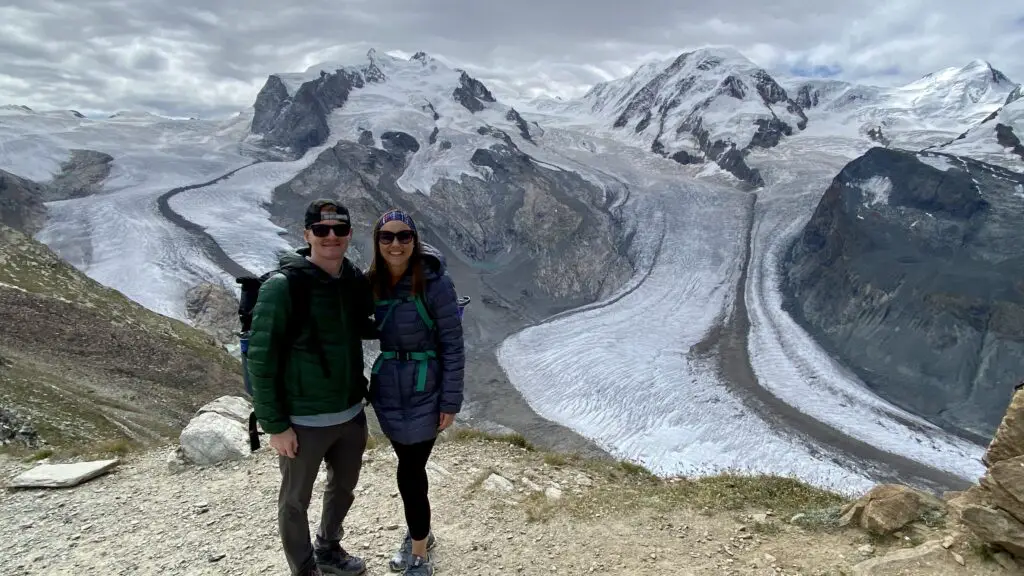
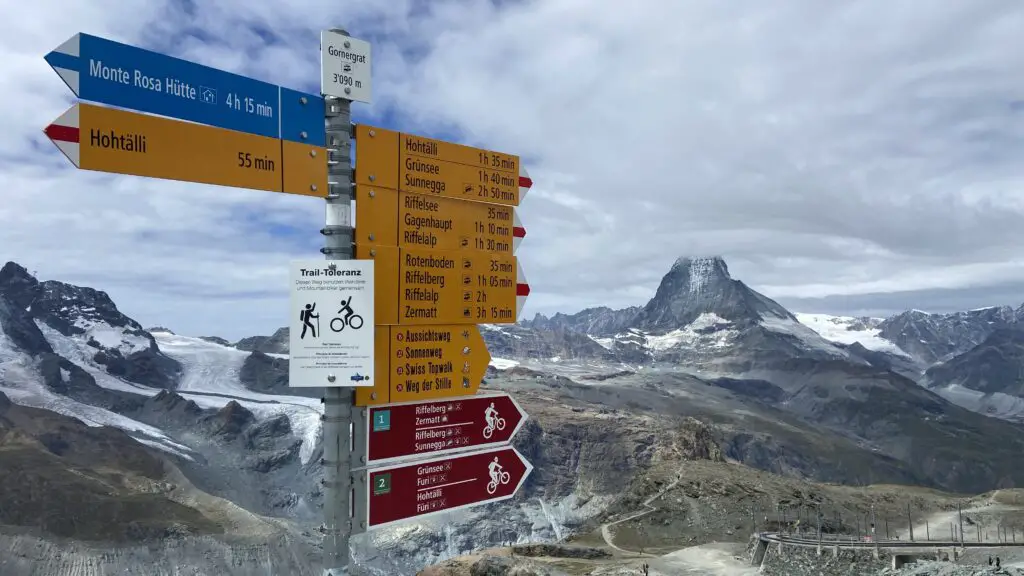
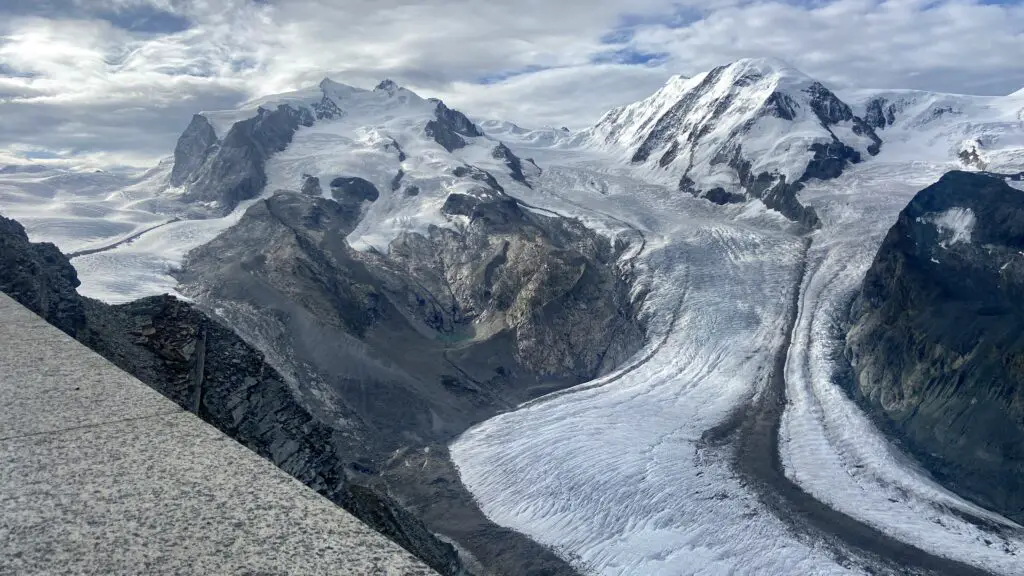
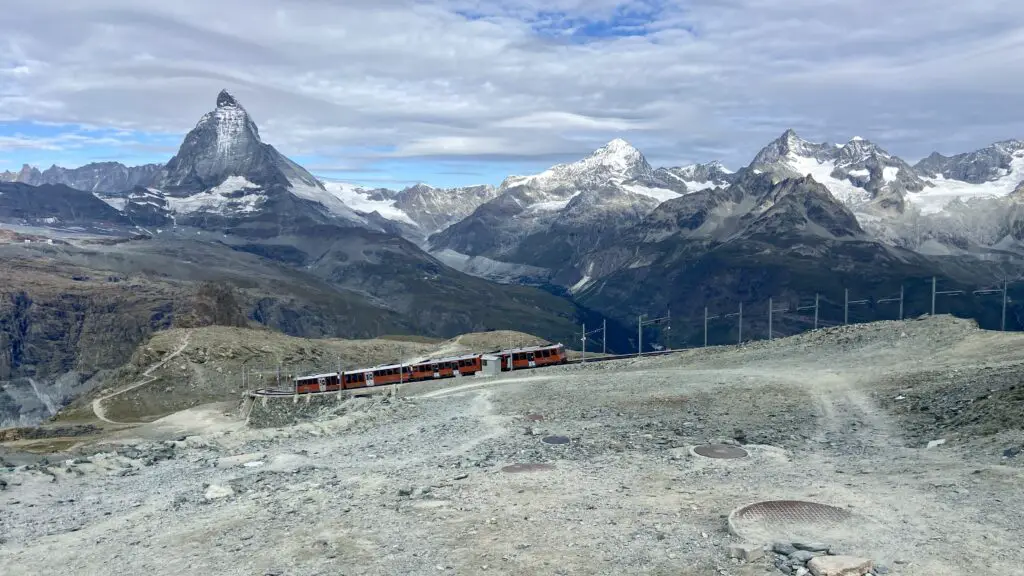
Bahnhofstrasse is where you’ll find most of the shops and restaurants, and many hotels and grocery stores are just a block or two off this road as well.

Remember that even though this is a pedestrian street, there are still electric vehicles. Please please please don’t be that oblivious tourist walking in the middle of the street holding up the traffic behind you. K, thanks 🙂
After about 7 minutes, you’ll reach the intersection of Bahnhofstrasse and Kirchstrasse. This is basically the center of town, right beside the Matterhorn Museum — which, as we mentioned earlier, is where you can learn about the history of mountaineering on the Matterhorn and the rise of tourism in Zermatt.
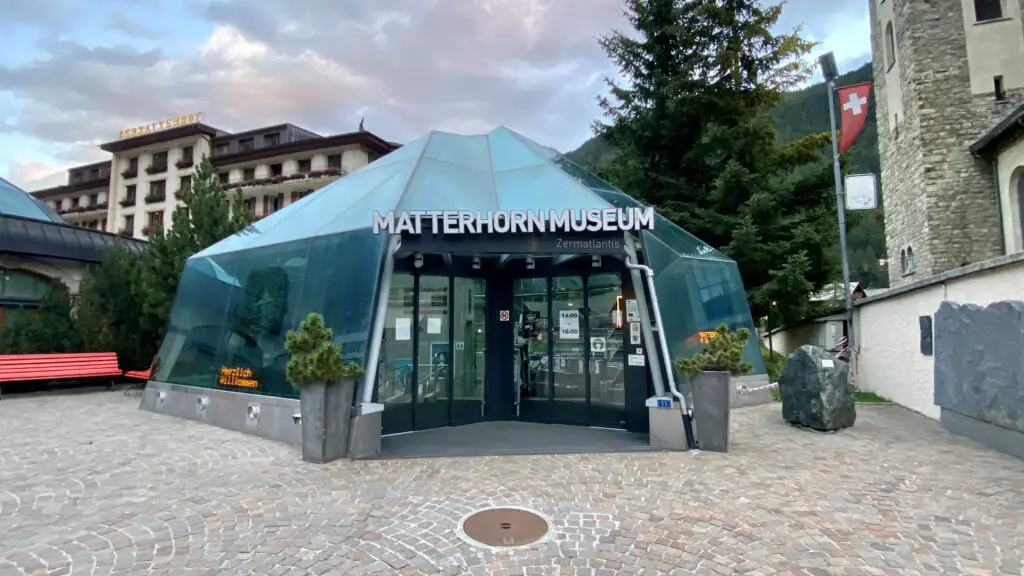
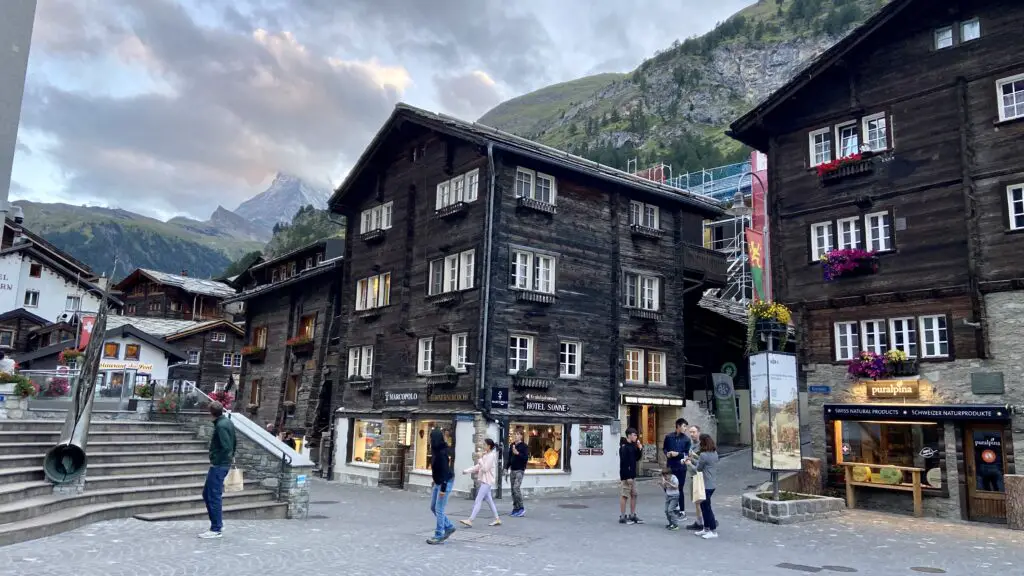
From here Bahnhofstrasse turns into Oberdorfstrasse. As you walk you’ll notice less shops, fewer restaurants, and more subtle lodging options. This is definitely a quieter part of the village that leads down to the river and directly to the gondola station for one of the main attractions: Glacier Paradise.
It’s just a 12-minute walk from the center of town, or a 20-minute walk from the Zermatt train station.
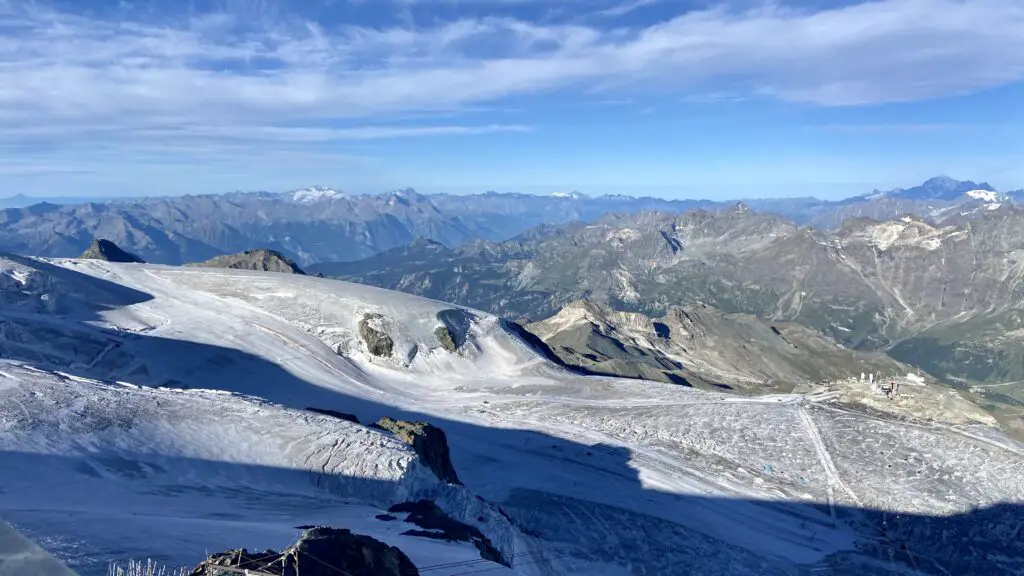
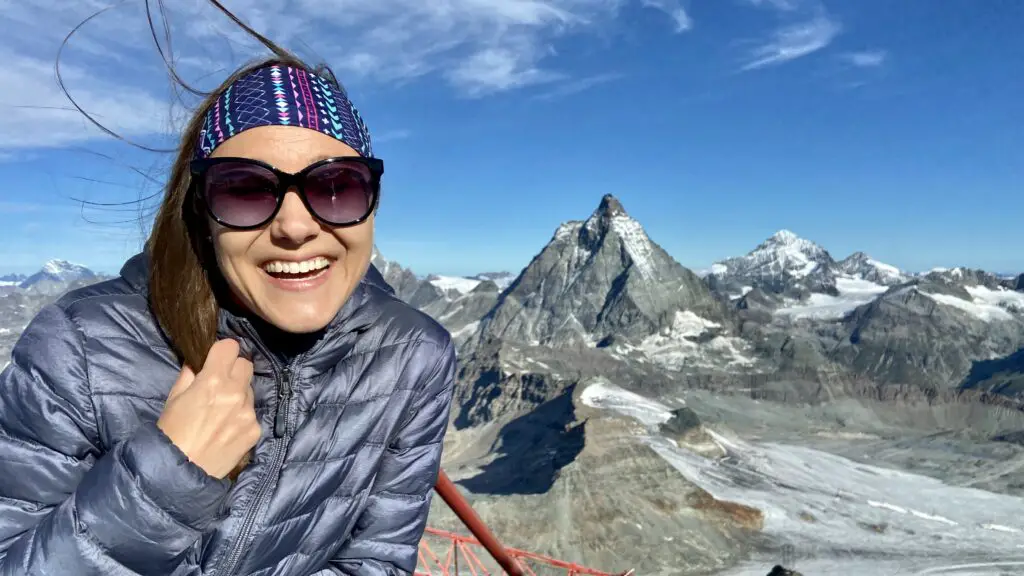

And if you haven’t heard, Glacier Paradise is the highest cable car station in Europe where you can walk beneath a glacier or ski 365 days a year.
ZERMATT INSIDER TIP #4
And this leads us to our next insider tip: If you search for Glacier Paradise on the SBB Mobile App, you won’t find it. Trust me, I made the same mistake the first time I looked for it too!
Instead, type in “Klein Matterhorn” and you’ll find exactly what you’re looking for, since this is the name of the actual mountain peak where Glacier Paradise is located.
We had to cross the water to get over here to the station, and that water is actually the Matter Vispa River, which runs all the way through town and basically splits Zermatt into two main sections.
There are roads running nearly the entire length of the village on both sides of the river. But at this point, you’re basically at the far end of the village.
Earlier, we mentioned that there are 3 ways to get around Zermatt — well, 4 if you include walking. Other than the hotel shuttles and e-taxis, the other option is to take an e-bus.
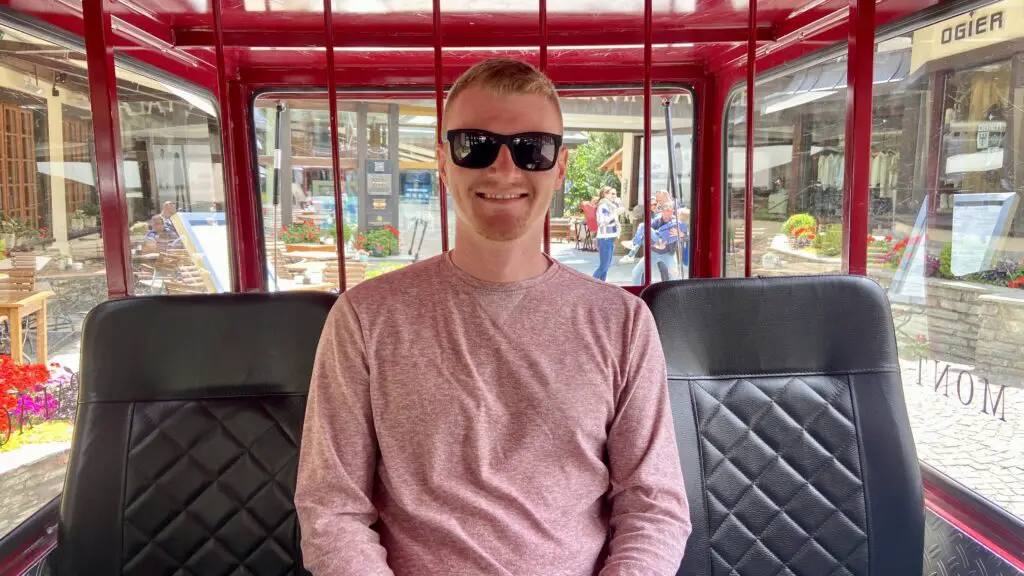

ZERMATT INSIDER TIP #5
So here’s our next insider tip: The public e-buses are free! You don’t need a ticket or pass to ride them — you can just hop on. And they run every 8-20 minutes, depending on the location of the stop and the time of day. There are 2 different bus lines, and they reach every major destination in town: the Zermatt train station, Gornergrat Railway station, the Glacier Paradise station, and the Sunnegga-Rothorn station — which is where we’re headed next.
Sunnegga-Rothorn
Along the way, you’ll cross under Kirchstrasse, which we mentioned earlier, that intersects with Bahnhofstrasse in the center of town. There are stairs and an elevator if you need to get up there.
But if you keep walking along the river, you’ll eventually make it to the Sunnegga-Rothorn station.
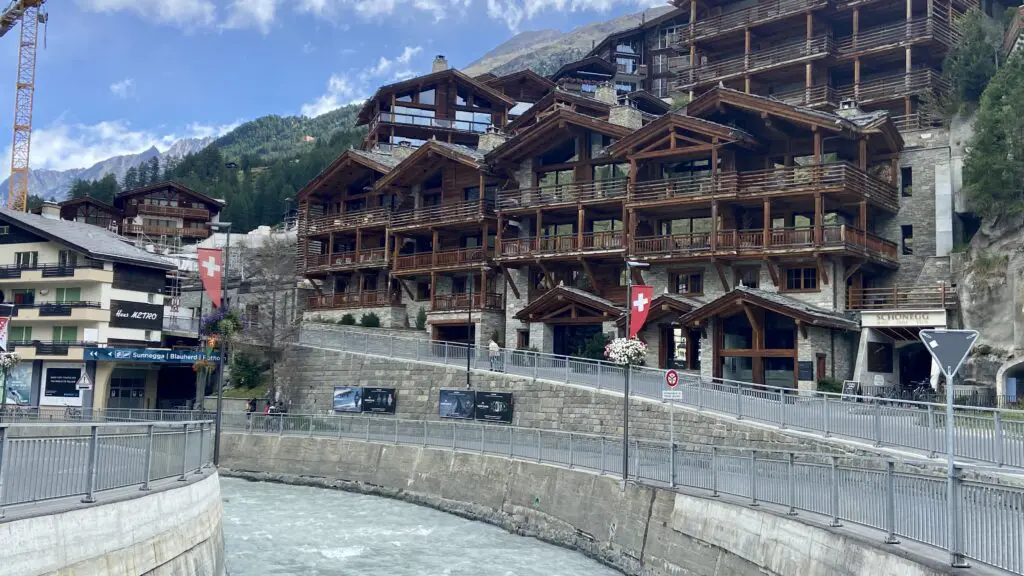
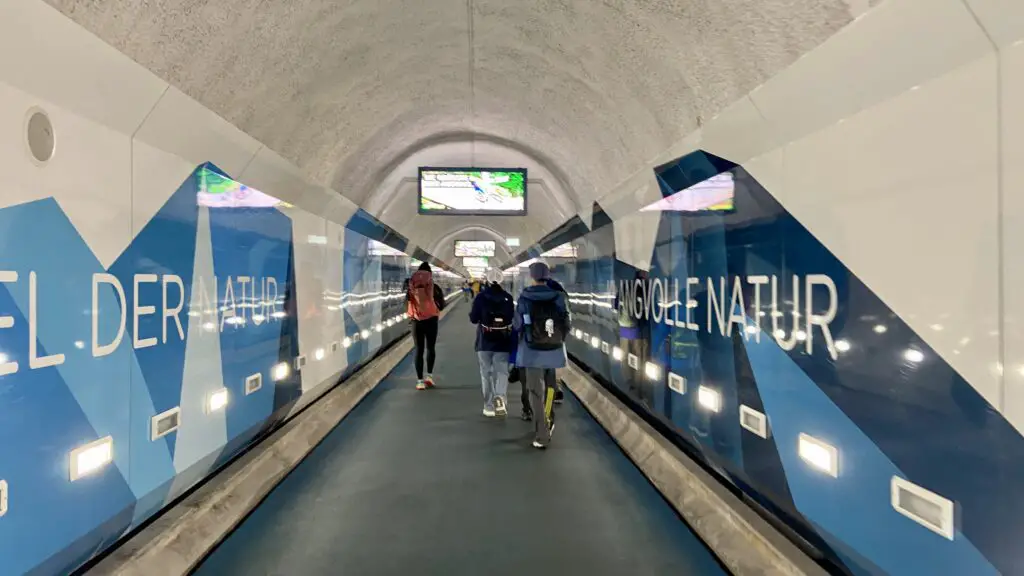

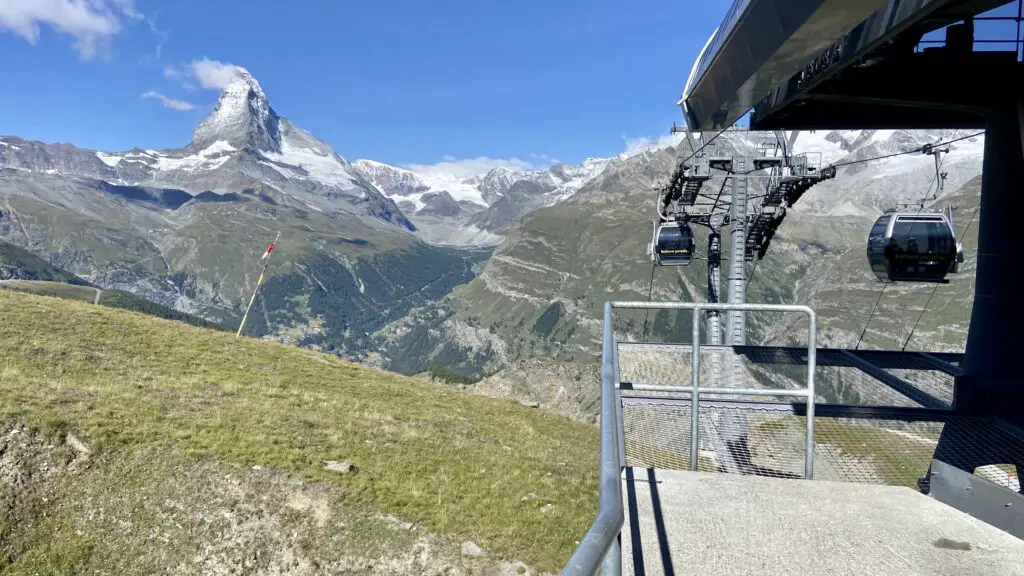
It took us 15 minutes to walk to the Sunnegga-Rothorn station from the Glacier Paradise station, but you could ride an e-bus and be here in just 5 minutes. And riding up this transportation line into the mountains takes you to the famous 5 Lakes Hike and the foodie paradise of Findeln.
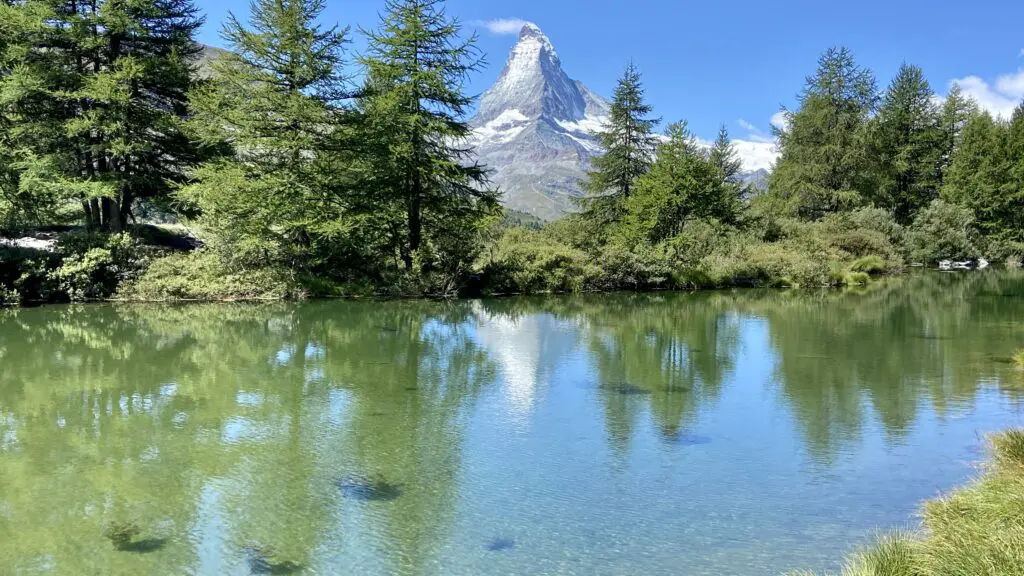
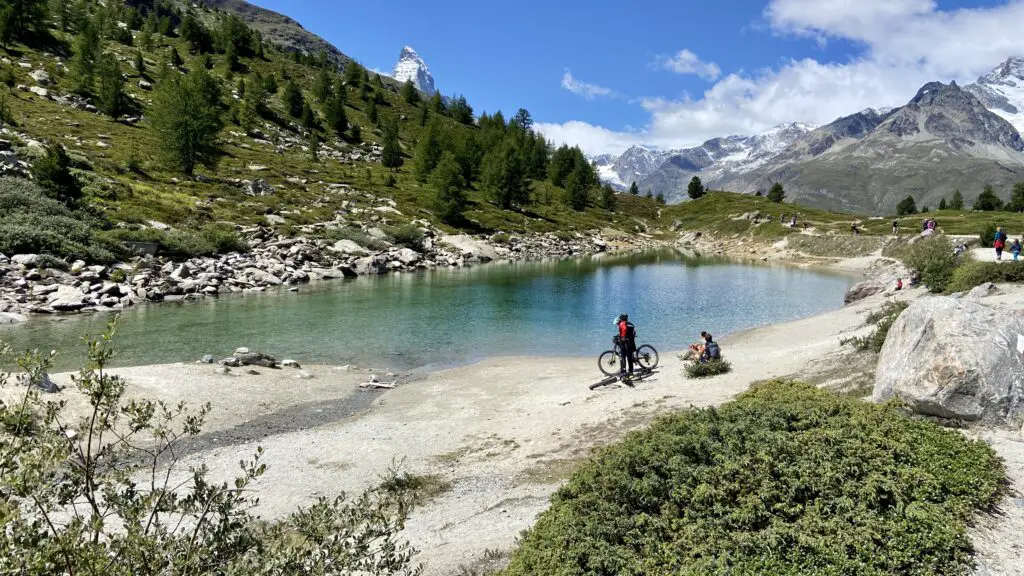
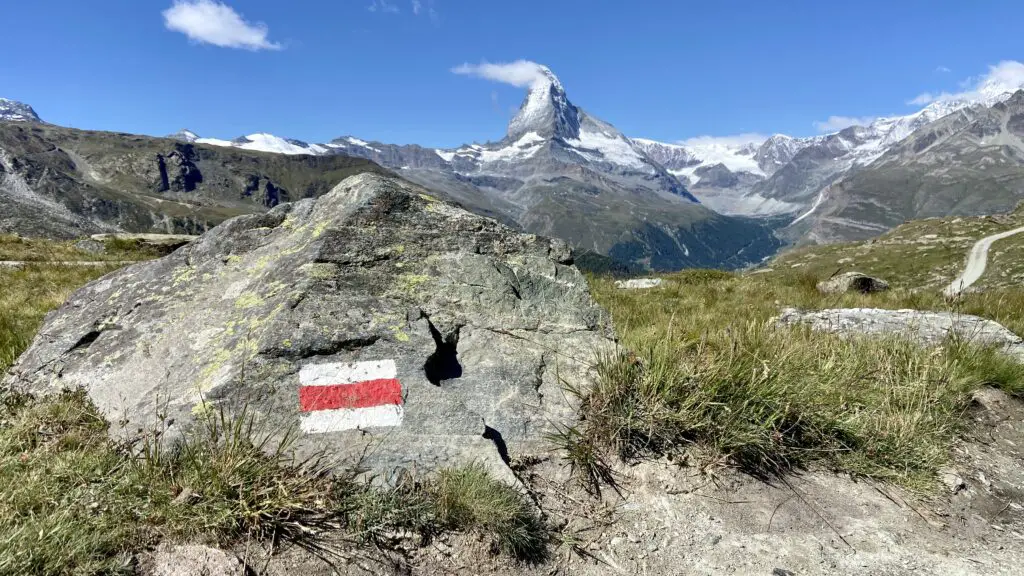

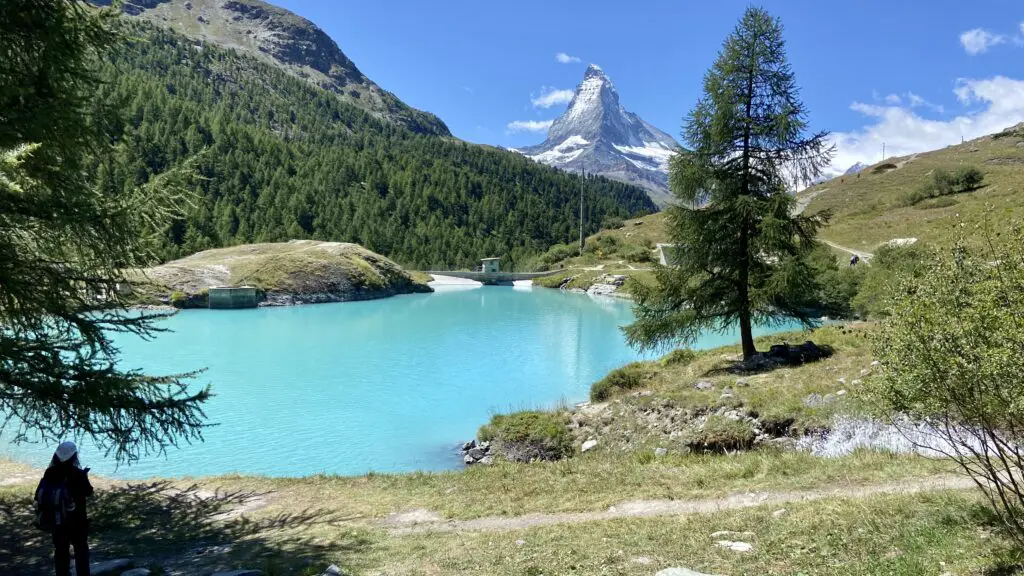
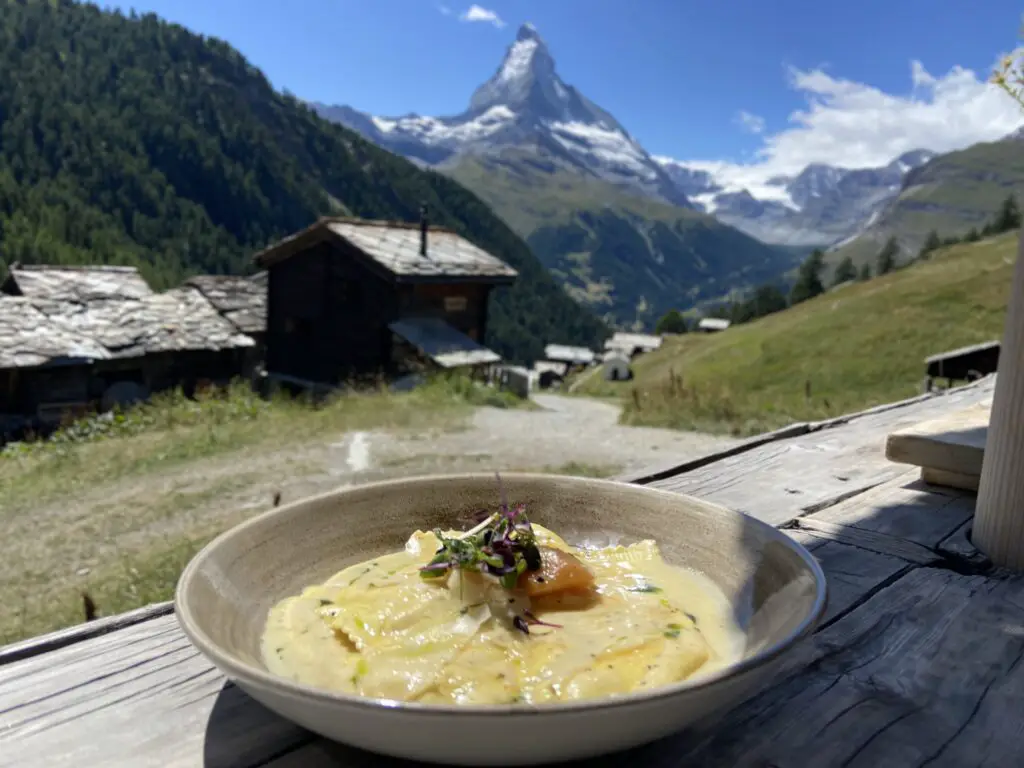
At this point, we’ve basically drawn two sides of a really long triangle, which you could complete by crossing back over the river and walking up Getwingstrasse for 7 minutes to reach the main square in front of the Zermatt train station, where we started our little village tour!
For context, Google Maps says this entire walk is just under 3 kilometers (1.8 miles) and would take about 45 minutes.
So to summarize our Zermatt Village Walking Tour:
- You’ll enter Zermatt at the train station.
- And the Gornergrat train station is right next door.
- Bahnhofstrasse/Oberdorstrasse runs through the middle of the village.
- The Glacier Paradise station is at the opposite end of the village just across the river.
- The river runs through the middle of the village as well.
- And the Sunnegga-Rothorn station is just across the river from the Zermatt train station and Gornergrat railway station.
Where To Stay in Zermatt, Switzerland
Knowing where the main sites are located is super helpful, but even more important is knowing where to stay.
Obviously, staying in the center of town is super convenient to access restaurants and transportation. But it is the most touristy and crowded.
Staying at the end of the village near the Glacier Paradise station is a lot quieter, although you’re not as close to many of the other restaurants or attractions.
The other side of the river is also quiet and has a lot of potential lodging options and restaurants, but you’ll have to walk a bit farther in order to reach the main sights and stations. But this is probably our favorite area to choose for lodging.
You could also consider Täsch, which is 15 minutes from Zermatt by train, or Randa, which is 20 minutes by train. But in our opinion, there are plenty of lodging options in Zermatt that are a lot more convenient. The only thing that could possibly sway our decision would be if the lodging was significantly cheaper.
But when we personally travel Switzerland — like our trip to Zermatt right now — and want to find the best prices on Swiss hotels, we use HotelCard. It gives you up to 50% off the price per night.
For example, on our last trip to Zermatt, 7 nights in hotels using HotelCard was actually cheaper than booking for a week on Airbnb! We saved an average of 83 CHF per night, so it might be worth checking out HotelCard before your next trip to Zermatt.
When To Visit Zermatt
You’ll also need to consider when to visit Zermatt — and you can theoretically visit any time of the year. Zermatt is a dream destination in the Winter, but we know that most of you are planning to visit during Summer.
ZERMATT INSIDER TIP #6
And in our opinion, the best time to visit is from Mid-June through early October.
During this season, pretty much everything is open, from mountain restaurants to cable cars to hiking trails, etc. Of course, the crowds and prices will be higher throughout this period.
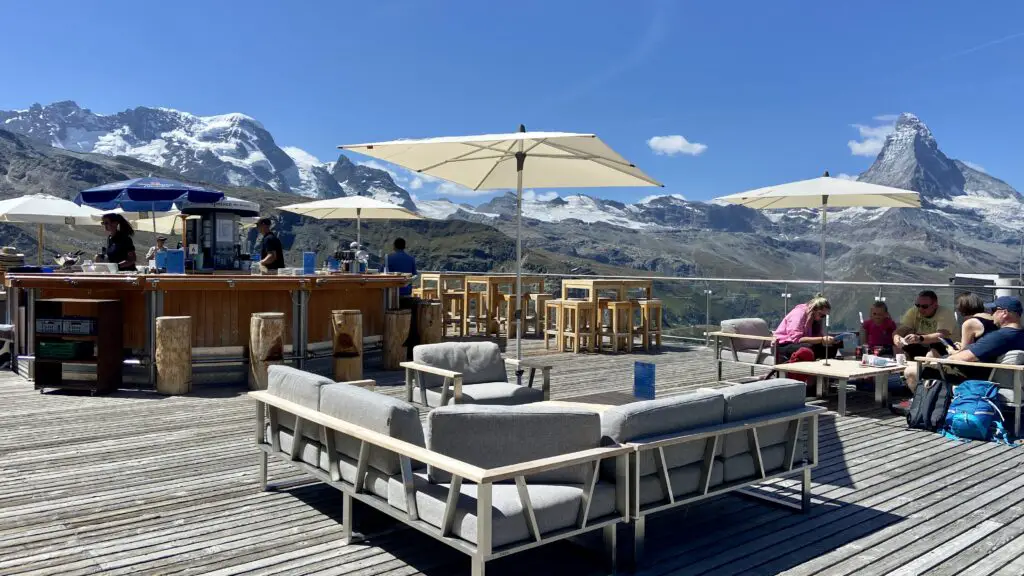
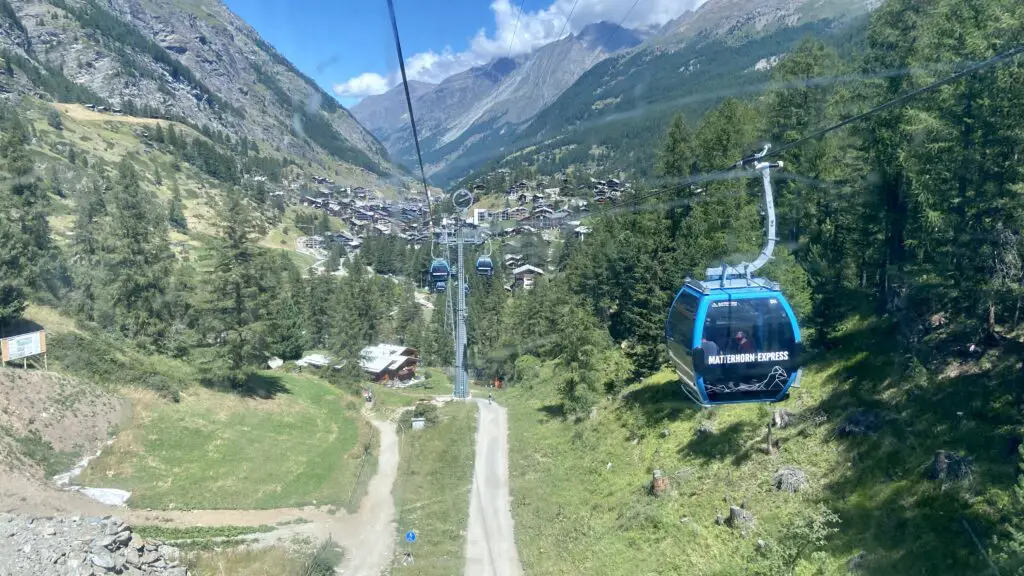
But be careful about visiting Zermatt during “shoulder season” — outside of July, August, and September (the true summer season), some destinations are unreachable, either because transportation is closed or because there’s still snow on the hiking trails. But it is good to know that you can reach both Gornergrat and Glacier Paradise year-round.
ZERMATT INSIDER TIP #7
But here’s another insider tip: Zermatt uses a dynamic pricing model for tickets, passes, and some activities based on the time of year. That literally means that the prices change depending on when you visit. We don’t recommend planning your trip solely based on when tickets are cheapest, but it is something to keep in mind.
How Long To Stay in Zermatt
Alright, we’ve covered a lot so far: how to get around town, where to stay, and when to visit. Now let’s talk about how long to stay. We’ve heard of so many travelers planning day trips or short overnight visits to Zermatt.
ZERMATT INSIDER TIP #8
But we think 3 full days is the perfect amount of time to spend in Zermatt. That’s why we crafted our Guide to Zermatt as a 3-Day Guide. There’s just so much to see here, and we think you can enjoy the highlights and a variety of different experiences — without going at a frantic pace — if you give yourself 3 full days.
Plus, shorter trips are always more expensive than longer ones (at least in terms of cost per day). And you want to give yourself the best chance of having full sunshine so you can enjoy those Matterhorn views you’re surely coming for!
ZERMATT INSIDER TIP #9
Speaking of weather, Zermatt is the sunniest area of Switzerland! Jana loves sunshine, so this makes her so joyful.


In fact, we read that 62% of days in Zermatt are bright and sunny, and Sunnegga — one of the mountain destinations here — literally translates to “sun corner.”
So give yourself 3 days and, while it won’t absolutely guarantee you those Matterhorn views you crave, you’ll have a reasonable chance!
Zermatt Elevation
We have a ton of travelers ask us for advice about altitude sickness. We’re originally from Tennessee, specifically the Nashville area, which sits right above sea level, so we totally understand this concern.
The peak of the Matterhorn sits at nearly 14,700 feet (4,478 m/14,692 ft). And while you’re unlikely to go to the top (no seriously, don’t even think about trying it), you might be concerned about the effects of altitude. After all, the village of Zermatt itself is already a bit over a mile high (1,620 m/5,310 ft).

In fact, Gornergrat (3100 m/10,170 ft) and Rothorn (3103m/10,180 ft) are just over 10,000 feet, and Glacier Paradise is almost 12,800 feet (3883 m/12,740 ft).
Compared to visiting the Jungfrau Region where we currently live, these are all higher than the Schilthorn, and Glacier Paradise is a whole 1000 feet higher than Jungfraujoch!
ZERMATT INSIDER TIP #10
So our next insider tip is actually a collection of 5 tips to help you beat the altitude:
- Tip 1 | Don’t do the highest elevation activities on your first day, especially if you just came from sea level. Spend some time in the village, or lower in the mountains on your first day to help you acclimate.
- Tip 2 | Alternate higher elevation days with lower elevation days. It’s amazing how even just one recovery day can give you an energy boost!
- Tip 3 | Give yourself time to rest! After going up in elevation, you may find yourself sleepier than usual — that’s normal! The air is thinner, which means there’s less oxygen and therefore your body has to work harder than at lower elevations. And we all know that more work makes us sleepier!
- Tip 4 | If you start to feel uncomfortable at higher elevations, sit down and eat something rich in carbs or sugar. This gives your body a quick jolt of energy (and is a great excuse to eat more Swiss chocolate).
- Tip 5 | If you’re anxious about elevation concerns, talk with your doctor before your trip. We are not medical professionals and this advice is just purely from our own experience — it’s not meant to diagnose, treat, cure, or prevent any altitude sickness.
Main Attractions in Zermatt, Switzerland
Another popular question we get asked is, “What are the can’t-miss attractions in Zermatt?” For example, is Glacier Paradise worth it? And what about the 5 Lakes Hike?
This question is exactly why we created our 3-Day Guide to Zermatt. It’s a done-for-you itinerary with minute-by-minute recommendations for how to spend your time in Zermatt — whether you’re just here to see the Matterhorn, want to do some hiking, or are ready to indulge in the best culinary village in the Alps.
Our Guide is chock full of bonuses too, like our favorite restaurants, how to reach Zermatt with the Glacier Express, the best viewpoints in town, and a few other bonuses you’ll just have to wait and see. So be sure to check out our 3-Day Guide to Zermatt.
Zermatt Train Passes and Transportation
Okay, since we were on the subject of excursions up into the mountains, you’re probably wondering what kind of train pass options there are, and Zermatt offers 2 possibilities:
The Peak Pass is the main pass for Zermatt, and it’s available year-round as a 1-day pass or all the way up to 1 month. It covers all of the gondolas, cable cars, and train lines up into the mountains.
And the second is actually a special ticket called the Peak2Peak ticket. It’s only available for about a month and a half in the peak summer season (no pun intended), but it could save you some money if you plan to visit Gornergrat and Glacier Paradise on the same day — which we don’t actually recommend, but we wanted to tell you about the option anyway.
ZERMATT INSIDER TIP #11
But you know we always have insider tips to maximize your transportation in Switzerland! And this tip is that the Half Fare Card is almost always the best choice when you’ve visiting Zermatt. We give all the details, as well as when you should consider those other two options, in our 3-Day Guide to Zermatt.
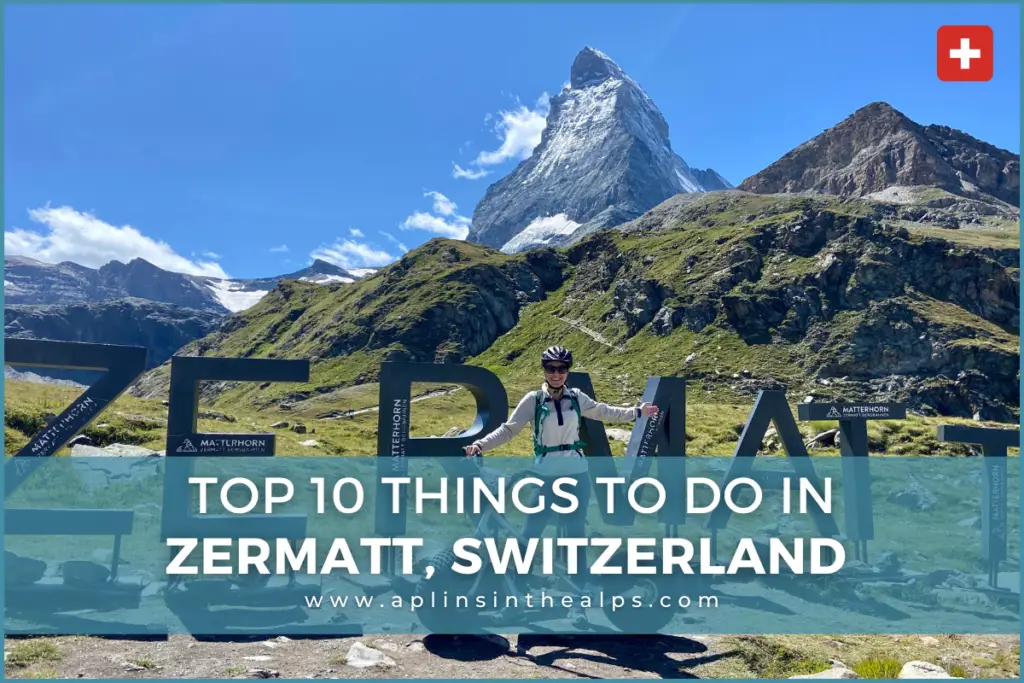
Wanting some more insider tips on Zermatt? Here’s our Top 10 things we think you need to do when you’re there!
Plan your next trip to Zermatt, Switzerland!
Zermatt might be one part of your Swiss Vacation, but most of you will probably see more than just Zermatt on your next trip to Switzerland.
So read this blog to learn 50+ things you need to know before your Swiss vacation, and check out our Swiss Travel Guides so you can maximize your experiences, minimize your planning time, and travel Switzerland with confidence. We’ll see ya in Switzerland!

